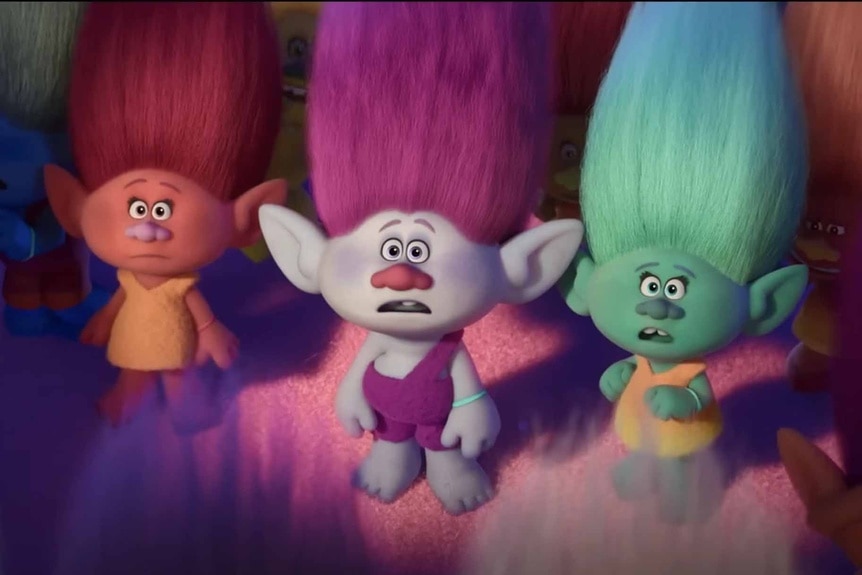Create a free profile to get unlimited access to exclusive videos, sweepstakes, and more!
Understanding Perfect Harmony: The Science Behind Trolls Band Together
Musical harmony is part math, part matter, and part mind magic.
The Trolls animated film franchise has made a universe out of the magical power of music, and the latest entry, Trolls Band Together, is no exception. Anna Kendrick returns as Poppy, alongside love interest and narrative sidekick, Branch (Justin Timberlake).
This time, Branch takes the lead in a high-stakes adventure to rescue his brother, reunite his family, and unleash the ultimate musical power. As a child, Branch was one-fifth of a brotherly boy band called BroZone. After failing to achieve a Perfect Family Harmony – a magical superpower unleashed when Troll musicians perform in perfect sync – BroZone breaks up and the brothers go their separate ways.
Years later, about a month after the events of Trolls World Tour, one of Branch’s brothers is kidnapped by a pair of sadistic singers, and the only thing that can save him is a Perfect Family Harmony.
For More on Musical Science:
Listen to the Music at the Heart of the Milky Way
New Musical Instrument Translates Sounds of Every Element on the Periodic Table
Rocking Rats Become First Non-Human Animals Studied Headbanging to Music
Surprise, Surprise, Music Is (Not So) Secretly Math!
If there is any true magic in the world, music might be it. By playing or singing the right notes, in the right sequence, you can make people move involuntarily, and tease out every emotion imaginable. A good beat can get people on the dance floor, but if you want someone to feel all the feels, nothing beats harmony.
Most of us might not know what makes a good harmony, why some collections of notes are pleasing to the ear and others aren’t, but we know it when we hear it. In simple terms, a harmony emerges whenever different notes are combined in a way which produces a pleasing sound greater than its individual parts.
There is something mathematical and quantifiable at play, but also something emotional and more abstract. First, the math. A group of notes or tones played at the same time is called a chord and there are common note combinations, common chords, which make up the majority of Western music. When we look at harmonious chords, we find that their notes exist in neat mathematical relationships with one another. And when those relationships slip out of sync, music becomes discordant and noisy, it loses its harmony.
Much of the early work on harmonies was done by Pythagoras, the Greek dude responsible for making you calculate the size of triangles in grade school. He grokked that there was a mathematical relationship between notes which could be demonstrated by cutting and plucking strings of different lengths. Anyone who’s ever looked under the hood of a piano knows there’s a relationship between the length of a string and the note it delivers.
Pythagoras figured out that the ratio of string lengths in a collection of notes determines whether those notes are harmonious or discordant. Two strings with a ratio of 2:1 will deliver the same note at different octaves, while strings with ratios of 2:3 or 3:4 will return a fifth note and fourth note, respectively. The distance between notes is otherwise known as an interval and the above three interval ratios make up many of the primary intervals from which Western harmonies are made.
But Why Do Harmonies Make Our Brains Feel Good?
Every sound you hear is just your brain’s way of interpreting vibrations in the environment. It’s easy to forget that every word you speak and every song you hear are only the air jiggling in discernable ways. Sound waves move through the air and strike the biological machinery in your inner ear where they are transmitted and interpreted by your brain. If we were to strike a single piano key, waves would ring out in a single tone, jiggling your ear in just one way but when multiple notes are played together, all of those waves are moving through the air, through one another, and into your ear at the same time.
Sometimes those waves line up and reinforce one another. We see something similar in the ocean when the movements of multiple individual waves stack up on top of one another and create a massive rogue wave seemingly out of nowhere. Other times, the waves cancel each other out, but if the frequencies of notes have ratios like the ones listed above, they hit your ear in perfect harmony. That’s because your brain is a huge dork for simple fractions.
Going back to Pythagoras (also a huge dork) and his strings, we see that octaves of the same note, no matter which note, always have ratios of 2:1. For example, the note A below Middle C (A3) has a frequency of 220 Hz, while A above Middle C (A4) has a frequency of 440 Hz. If you mash those two notes together at the same time, something in your brain starts drooling. That’s because octaves, the simplest of all musical fractions, are the most consonant (pleasing) intervals there are. The next simplest fractions, 3/2 and 4/3 (the fifth note and fourth note, you recall) are the next most consonant, and so on.
When you stack notes whose ratios have simple fractions, you get nice and pleasing harmonies. If you stack notes with more complex ratios, you get more dissonant and less pleasing sounds. Harmony exists not in the notes themselves but in the relationship between those notes. In the end, the psychic tastiness of harmonies might come down to processing power. Those simple fractions are easy for our brains to parse, they go down smooth. More cacophonous note collections are difficult to tease out, they’re messy and have sharp corners. In general, the closer you can get to mathematical neatness, the better your chord harmony is likely to sound, but there might be a limit.
A recent study published in Nature Communications found that people prefer music with a little imperfection over perfect harmony. "We prefer slight amounts of deviation. We like a little imperfection because this gives life to the sounds, and that is attractive to us," said co-author, Dr. Peter Harrison, in a statement. It’s nice to know that in music, as in life, as long as you’re aimed toward harmony it’s alright if you stumble a little.
Find your place in the harmony with Trolls Band Together, available from Universal Pictures.
































